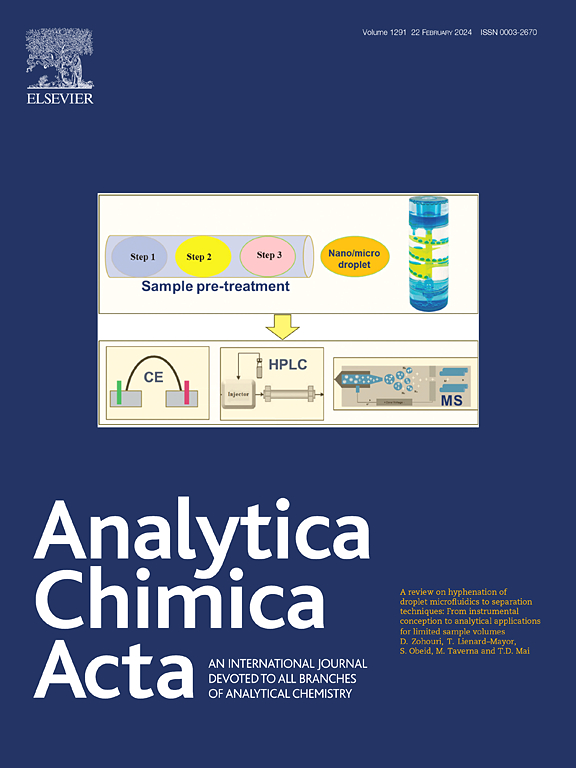一种多功能二维液相色谱耦合高分辨率质谱平台,用于解开大型合成寡核苷酸的色谱图谱
IF 5.7
2区 化学
Q1 CHEMISTRY, ANALYTICAL
引用次数: 0
摘要
许多基因表达调节疗法以及聚集规律间隔短回文重复序列(CRISPR)-Cas9基因编辑技术已经极大地改变了生物医学研究领域。一些临床试验已经很好地证明了基于寡核苷酸的治疗方法在解决许多疾病领域的潜力。因此,寡核苷酸的质量和完整性对于确保疗效和最终的患者安全至关重要,这通常需要彻底的表征。一般来说,这些寡核苷酸是通过固相磷酰胺化学合成的,在此过程中,可能会产生许多不完全反应或副反应产生的可能不需要的副产物。然而,从完整水平对大型合成寡核苷酸的整体色谱谱的检查受到直接耦合质谱(MS)的限制和挑战。这不仅是由于杂质的丰度低和非均质性,而且是由于分离困难。此外,许多在线耦合质谱的寡核苷酸分离方法存在灵敏度不佳的问题。为了解决这些挑战,我们开发了一种多功能的二维液相色谱-质谱(2lc - ms)平台,包括多重心脏切割分离、加合物去除和通过宽窗口四极杆分离获取。以100 mer长的单导核糖核酸(sgRNA)为模型化合物,深入分析了sgRNA在低温下的IP-RPLC图谱和HILIC图谱。总体而言,通过利用2lc - ms平台,我们能够获得一个主要的灵敏度提升,以检查大型合成寡核苷酸的色谱谱,实现批次间的比较和对杂质谱的理解。本文章由计算机程序翻译,如有差异,请以英文原文为准。

A versatile two-dimensional liquid chromatography coupled to high-resolution mass spectrometry platform for unraveling chromatographic profiles of large synthetic oligonucleotides
Background
Many gene expression-modulating therapeutics, as well as clustered regularly interspaced short palindromic repeats (CRISPR)-Cas9 gene editing technology have greatly transformed the field of biomedical research. A number of trials already in clinic well exemplify the potential of oligonucleotide-based therapeutics to address many disease areas. The quality and the integrity of the oligonucleotides are therefore crucial to ensure efficacy and ultimately patient safety, which often require thorough characterization. In general, these oligonucleotides are synthetically made by solid phase phosphoramidite chemistry, during which many possible undesired byproducts from incomplete or side reactions can be generated. However, the examination of the overall chromatographic profile on the large synthetic oligonucleotides from the intact level has been limited and challenging by direct coupling to mass spectrometry (MS). This is due not only to the low abundance and heterogeneity of impurities, but also to difficulties in separation. Furthermore, many oligonucleotide separation methods coupled online to MS greatly suffer from suboptimal sensitivity of the MS detection.
Results
Here, to address these challenges, we develop a versatile two-dimensional liquid chromatography-mass spectrometry (2DLC-MS) platform involving multiple heart-cut fractionation, adduct removal, and acquisition through wide window quadrupole isolation. Using a 100-mer long single guide ribonucleic acid (sgRNA) as the model compound, we showcased the in-depth analysis of the sgRNA IP-RPLC profile as well as HILIC profile at lower temperature.
Significance
Overall, by utilizing the 2DLC-MS platform, we were able to gain a major sensitivity boost to examine the chromatographic profiles of large synthetic oligonucleotides, enabling lot to lot comparison and understanding of impurity profiles.
求助全文
通过发布文献求助,成功后即可免费获取论文全文。
去求助
来源期刊

Analytica Chimica Acta
化学-分析化学
CiteScore
10.40
自引率
6.50%
发文量
1081
审稿时长
38 days
期刊介绍:
Analytica Chimica Acta has an open access mirror journal Analytica Chimica Acta: X, sharing the same aims and scope, editorial team, submission system and rigorous peer review.
Analytica Chimica Acta provides a forum for the rapid publication of original research, and critical, comprehensive reviews dealing with all aspects of fundamental and applied modern analytical chemistry. The journal welcomes the submission of research papers which report studies concerning the development of new and significant analytical methodologies. In determining the suitability of submitted articles for publication, particular scrutiny will be placed on the degree of novelty and impact of the research and the extent to which it adds to the existing body of knowledge in analytical chemistry.
 求助内容:
求助内容: 应助结果提醒方式:
应助结果提醒方式:


